Issue Archive
Table of Contents
BLOOD COMMENTARIES
SPECIAL REPORT
Artificial intelligence in hematology
In the last 2 years, the capabilities of artificial intelligence (AI) have progressed rapidly and are increasingly being integrated into hematology practice. In this Special Report, Nazha and colleagues from the American Society of Hematology Subcommittee on AI outline how different AI subtypes are already being used. For example, machine learning algorithms can interpret peripheral blood and natural language processing tools to extract clinical and laboratory information from electronic health records. The authors discuss potential future applications and guardrails that will be needed. While challenges remain in evaluation and implementation, hematologists will increasingly use AI to enhance diagnostics, improve workflows, and personalize treatment.
CLINICAL TRIALS AND OBSERVATIONS
Disease risk but not remission status determines transplant outcomes in AML: long-term outcomes of the ASAP trial
Clinical Trials & Observations
Current practice for patients with acute myeloid leukemia (AML) is to try to induce a complete remission before allogeneic hematopoietic cell transplantation. Stelljes et al report long-term results of the ASAP trial, where 281 patients with relapsed or poor-response AML were randomized to receive salvage chemotherapy or undergo immediate transplantation. Overall, survival at 5 years is not different between the 2 arms, and the major predictor of survival is genetic AML risk according to the European LeukemiaNet classification, with age and comorbidities also being significant. These findings challenge the routine use of intensive remission induction before allogeneic transplant in patients with an available donor and underscore the need for novel therapeutic strategies for poor-risk AML.
HEMATOPOIESIS AND STEM CELLS
Metabolic adaptation of regenerative hematopoiesis depends on docking-independent mitochondrial connexin 43
Connexin 43 (Cx43) plays a critical role in mitigating excessive reactive oxygen species in hematopoietic stem cells (HSCs) during stress hematopoiesis by mediating intercellular mitochondrial transfer, but the underlying mechanisms have remained poorly defined. Singh and coauthors demonstrate that actively cycling HSCs require mitochondrial Cx43 during periods of replicative stress to preserve mitochondrial metabolism, maintain matrix calcium homeostasis, and sustain adenosine monophosphate–activated protein kinase signaling to promote effective hematopoietic regeneration in vivo. These findings suggest that modulation of Cx43-dependent pathways could protect HSCs from exhaustion during regeneration and potentially enhance HSC transplantation outcomes.
IMMUNOBIOLOGY AND IMMUNOTHERAPY
A BCMA-mRNA vaccine is a promising therapeutic for multiple myeloma
RNA vaccines are an active area of investigation in cancer, with early clinical studies targeting both shared and neoantigens. Dutta et al report on a preclinical study of a lipid nanoparticle vaccine for multiple myeloma encoding B-cell maturation antigen (BCMA)-mRNA and the adjuvant polyinosinic:polycytidylic acid. The vaccine elicited BCMA-specific T-cell responses in vitro and in vivo, and the induced BCMA-specific T cells were able to kill BCMA-expressing myeloma cells. These results justify clinical testing of this vaccination approach in patients with myeloma
LYMPHOID NEOPLASIA
Multiomics analysis reveals the genetic and epigenetic features of high-risk NK cell–type chronic active EBV infection
Chronic active Epstein-Barr virus (CAEBV) infection, characterized by chronic infection of B,T, or natural killer (NK) cells by EBV, is a heterogeneous disease with diverse clinical courses and an incompletely understood pathogenesis. Akazawa and colleagues conducted a multiomics analysis to dissect genetic and epigenetic factors in NK-CAEBV and identified a high-risk subtype of NK cell–type CAEBV characterized by tumor-like features, including a high CpG island methylation pattern, a higher tumor mutation burden, and frequent copy-number alterations. These findings suggest that stratifying patients with NK-CAEBV based on molecular subtype could improve prognostic accuracy and guide treatment decisions.
MYELOID NEOPLASIA
Venetoclax plus gilteritinib is effective in preclinical models of FLT3-mutant BCL11B-a lineage-ambiguous leukemia
Brief Report
Lineage-ambiguous acute leukemias with aberrant activation of BCL11B (BCL11B-a leukemias) currently lack targeted therapeutic options, but high expression levels of the tyrosine receptor kinase gene FLT3 and dependency of the antiapoptotic protein BCL2 offer prospects for targeted therapy. Montefiori et al report that BCL11B-a patient–derived xenograft models are highly sensitive to the combination of venetoclax plus gilteritinib. Although rare resistant subpopulations can persist, these findings provide a strong preclinical rationale for clinical evaluation of venetoclax plus gilteritinib in BCL11B-a and related acute leukemias of ambiguous lineage.
THROMBOSIS AND HEMOSTASIS
Molecular determinants of thrombosis recurrence risk across venous thromboembolism subtypes
Unprovoked venous thromboembolism (VTE) has a significant recurrence rate approaching 20% within 5 years, posing a major challenge in determining the optimal duration of anticoagulation therapy for individual patients. Munsch et al leveraged data from 6355 individuals with a first VTE, 1775 of whom experienced VTE recurrence, to conduct a genome-wide association study supplemented by transcriptome and Mendelian randomization analyses to identify 28 loci and proteins associated with VTE recurrence risk. This study provides genomic evidence that inherited variants contribute to the risk of VTE recurrence, raising the possibility of a more personalized approach to the prevention of recurrent VTE.
BLOOD WORK
ERRATUM
-
Cover Image
Cover Image
![issue cover]()
Immunofluorescence image showing mitochondrial recruitment of activated adenosine monophosphate–activated protein kinase (pAMPKα1/2-Thr172, green) in a connexin 43–deficient bone marrow hematopoietic stem cell. Mitochondria (red) and nuclei (blue) are depicted. See the article by Singh et al on page 2306.
- PDF Icon Front MatterFront Matter
- PDF Icon Table of ContentsTable of Contents
- PDF Icon Editorial BoardEditorial Board
Advertisement intended for health care professionals
Email alerts
Advertisement intended for health care professionals


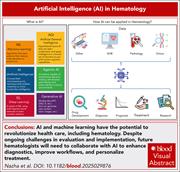

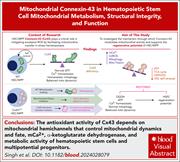
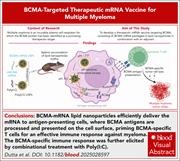
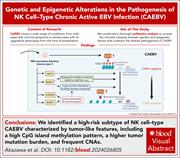
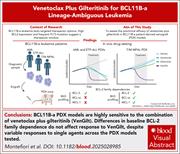
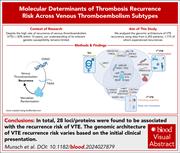

AML biology matters, so should we transplant ASAP?
Clinical Trials & Observations